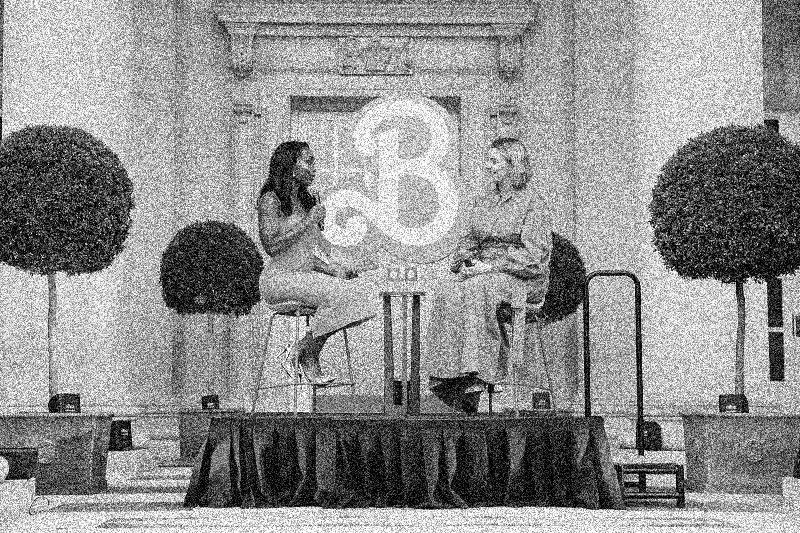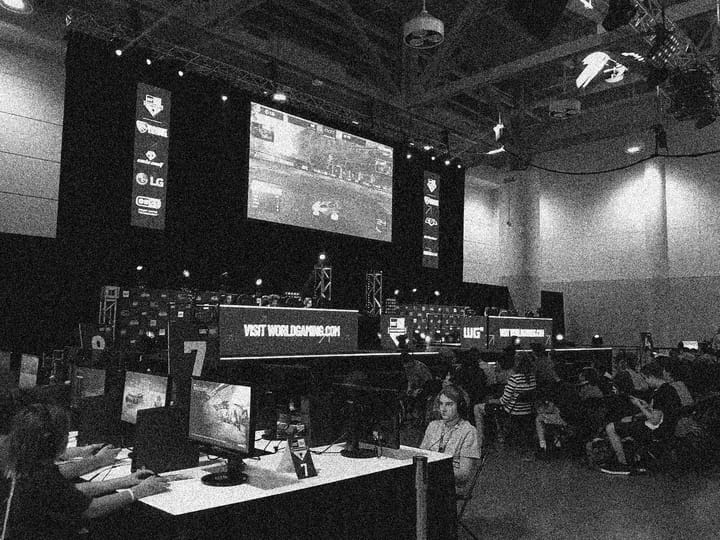Critical Cul-de-Sac
Contemporary film criticism increasingly takes the form of a ceaseless hunt for hidden messages in movies. In addition to producing outlandish interpretations, it is also confusing the role of art in society.

Radical film criticism—from Siegfried Kracauer to André Bazin—was banished to the dustbin of history, dragged down by the decay of the Soviet Union and the rise of cultural fatalism. Today it has reemerged in undead form, as an incessant plumbing of movies for subterranean political meanings.
Reviews are flooding the culture sections of niche and mainstream publications, digital and hardcopy alike, as writers search out covert agendas in the latest blockbusters. Princess Peach is scrutinized for her contributions to feminism, Joker forgets to mention the proletariat’s revolutionary character, and The Creator is dismissed as “demented propaganda” for “the coming AI onslaught.” Everything, it turns out, is an elaborate metaphor for capitalism—if Vox is to be believed, Minions: The Rise of Gru is onto some seriously deep shit.
Contemporary takes can often be wildly incongruent with their subject matter, as when critics note that Oppenheimer fails to cast a nice light on the women scientists who helped build the most vile device in creation, or when Forrest Gump appears alongside the white-supremacist film Birth of a Nation on a list of “movies that haven’t aged well.” TV is also caught in the critical crossfire, including a list of Tony Soprano’s worst offenses that ranks disrespecting women above committing murder.
I’ve taken to calling this interpretive style social-ish realism. Historically, realism referred to art that documented reality rather than merely offering an artistic statement or a form of entertainment. Contemporary criticism follows suit, challenging films to represent the world and provide “positive” true-to-life depictions of marginalized social actors/groups. But unlike the left-wing variant of socialist realism, social-ish realism draws its strength from cultural liberalism, and its critics rarely wonder why the latent signification of films matter in the first place. (Any similarity to the series Black-ish is coincidental, but that show could certainly be discussed as an example of how new media wrestles with representing modern selves and everyday life.)
For decades, politicized cultural critique has slowly been leaking out of the ivory tower. But the 2016 election of Trump—followed by the 2020 George Floyd protest movement and the chaos of the Covid-19 pandemic—led to a widespread sense that our society is rotten to the very core. Critics quickly got to work showing the arts were not immune to generalized decay. Consequently, social activist realism returned with a vengeance, prompting one writer to remark, “In 2023, it often feels like we can’t watch a film or a show without asking what service each character does for representation."
There is also an emerging tradition of politically motivated representational film, with Captain Marvel standing as one obvious example of how big brands are marrying box office appeal with social movements. There are other, more explicitly political examples dealing with topics such as anti-racism, including Juel Taylor’s They Cloned Tyrone, as well as boundary-pushing films that contain veiled social content like Jordan Peele’s Nope. Some directors have even adopted the language of film as a social cryptogram, with director Elizabeth Banks commenting on Cocaine Bear’s script, “I felt there was no greater metaphor for the chaos of life than a bear high on cocaine.”
To date, the apex of modern criticism is the hubbub around Greta Gerwig’s Barbie. The film positioned itself at the center of 2023 cultural discourse with its feminist message, attracting a wave of hot takes across the political spectrum. Since the movie was developed in partnership with the long-maligned toy brand Mattel, sympathetic critics were eager to reconcile its appealing message with its mass appeal as a big-ticket commercial venture.
While some crabby writers decided Barbie was a “Mattel commercial” and “corporate propaganda,” a Rolling Stone review jumped through hoops to characterize the movie as “the most subversive blockbuster of the 21st century to date.” The article insisted that the film was able to achieve this great act of subversion by packing a density of meaning into the film’s sub-structure:
Barbie adds levels of intelligence and interrogation into not just the script, co-written by Noah Baumbach, but the narrative itself. Rather than turn away from the baggage, the movie unpacks it. What was it about these dolls we loved, and what is it about them that now causes such divisive emotional reactions? Let’s not just drop Barbie and Ken into the real world circa 2023—let’s have them question what it means to be plastic role models that run up against modern attitudes about womanhood and Neanderthal notions of manhood.
As proof of Barbie’s seriousness, the review compared the film to Ibsen’s A Doll’s House and zeroed in on Gerwig’s references to Kubrick and Proust. The author concluded with a straight face that the film’s messaging goes so deep, “it’s hard to not feel like you should be receiving college credits for watching even as you nod along.”
Contemporary criticism adopts the language of subversion, which affords it a quasi-radical allure in our politicized moment. But it is often difficult to locate what is specifically forward-thinking about celebrations of industry profits or cheers for the “unworldly idealism” of Pixar.
Regardless, the critical style is proliferating. People are systematizing the models via platforms like Mediaversity, generating quasi-algorithmic proofs of a movie’s virtues and failings. Critical negativity and skepticism are also drifting into other spheres, with food magazines examining meat as a “literal metaphor.” Even conservatives, ever tortured by their rear-guard status in culture, have found a way to participate, leading to some extremely embarrassing takes.
Realism in the Balance
The current wave of criticism is rooted in a tacit assumption that all films have important covert political meanings. That is to say, critics take for granted that social reality is not only visible when characters explicitly make progressive/reactionary statements, but also when the critic locates themes encrypted in the very structure of the work. In this spirit, contemporary criticism challenges us to look beyond the surface, finding submerged truths lurking in the depths.
This view implicates modern criticism in historical debates about artistic realism. The idea of cinema as a mirror of social reality is an old one, dating back to the early years of Left film criticism. The German film critic Siegfried Kracauer was a strong believer that art mirrored society and revealed its truths. In a series of 1927 essays, he argued:
Films are the mirror of the prevailing society…. In order to investigate today's society, one must listen to the confessions of the products of its film industries. They are all blabbing a rude secret, without really wanting to. In the endless sequence of films, a limited number of typical themes recur again and again; they reveal how society wants to see itself. The quintessence of these film themes is at the same time the sum of the society's ideologies, whose spell is broken by means of the interpretation of the themes.
Kracauer compared these repetitious and specular cinematic products with the self-consciously realist film, contending, “Films come into their own when they record and reveal physical reality…. Films are true to the medium to the extent that they penetrate the world before our eyes.”
Realism as a socio-cultural revolutionary style was not accepted by all Marxists, particularly after socialist realism was adopted as the official artistic style of the USSR. Kracauer’s friend T.W. Adorno was especially critical. He denied that film could “integrate photography and its derivatives into art despite the limitations defined by their dependence on empirical reality.” Instead, Adorno highlighted montage technique, which “goes beyond photography immanently without infiltrating it with a facile sorcery, but also without sanctioning as a norm its status as a thing: It is photography's self-correction.”
The debate about realism touched every major artistic medium. A musician by training, Adorno set his sights on musical forms like jazz and framed avant-garde modernism as the antidote to mass culture’s stilted realism. In a similar vein, Ernst Bloch lauded surrealism for reflecting the disfigurement of reality in the modern age. Meanwhile, realism found advocates across the world, with Frida Kahlo characterizing her art as “revolutionary realism” and CLR James treating the narrative of Moby Dick as a fundamentally realist depiction of the paradigmatic capitalist subject.
A Metaphor for Capitalism
Looking back on these texts today, it’s easy to feel a pang of nostalgia for their rigor and intensity. Even so, they sometimes illustrate the pitfalls of an interpretive practice that is so popular and reified today.
A diverse set of Marxist critics rooted their interpretive models in homologies, or analogies between two different structures. (The term homology is most common in science, as when similarities in the structure of bird bones are cited as evidence of evolutionary relationships.) In the case of art, homologies are made when someone compares or draws out relationships between artistic forms and social forms. Adorno’s jazz analysis, for example, suggested there was a meaningful resemblance between the standardized musical forms of jazz and the formulaic nature of assembly line commodities.
In their best moments, Marxist cultural critics made convincing arguments about how art mirrors life and distorts it for ideological purposes. But one risk with readymade homologies is that they can end up being arbitrary, since everything—from bird bones and jazz standards to buildings and the global economy—can be talked about in terms of “structure.” Critics have an easy time creating analogies between any two structures, but they tend to stumble when it comes to establishing a causal relationship or spelling out what that comparison might mean for revolutionary practice.
There is seldom a way to demonstrate that the nature of capitalist reality caused specific plot details in specific artworks. In the case of Adorno’s jazz analysis, there wasn’t literally a connection between the music and the factory. Songs were not produced on a Fordist assembly line or regulated by socially necessary labor time; they were composed by songwriters under a handicraft model common to any number of artisan-produced objects.
Given the fuzzy nature of homology, it can also be tough to follow early critics on their more fantastical political proclamations. When pushed against the wall, the realist critic György Lukács doubled down on the implication that an afternoon spent perusing a Thomas Mann novel would inspire the masses to take to the streets in support of the Popular Front. As he maintained, “through the mediation of realist literature, the soul of the masses is made receptive for an understanding of the great, progressive, and democratic epochs of human history.”
Over time, left-wing cultural critics such as those who worked in the Birmingham School adopted homology as a core analytic technique. In the 1980s and ‘90s, their model was combined with a watered down form of Frankfurt School critique, leading to a form of neo-realism that cast films, music, and other artforms as simple reflections of society and popular taste. The new realism that emerged forgets the political movements and the class struggle that accompanied the rigorous historical debates, keeping only the homologies and the high-flying rhetoric.
But Adorno, Kracauer, and others were debating the merits of German culture as the Nazis were issuing dictates about German culture. As Jewish writers forced into exile by fascism, they had a concrete reason to believe totalitarianism was woven into everyday life. And defenders of the USSR’s socialist realism were defending the regime they believed was the working class' last weapon against fascism.
Today, there is no Party that functions as a guide for political culture. It has never been easier to pluck analogies at random from the critical grab bag, leading to a carnivalesque range of social critiques. And without the paychecks that the Soviets sent to Marxist researchers, critics can’t be particularly bothered to ask why a given movie is a homology for anything at all.
Art at a Standstill?
One tempting rejoinder to the current state of hyper-politicization is to retreat into the view that art is just art. Perhaps we all just need to relax and enjoy the show, celebrating style and form like the aesthetes of the last two centuries.
In a recent New York Times op-ed, columnist Jason Farago alleged that the politicization of art is a symptom of a broader cultural “standstill.” Farago explained that we are still modernists who crave innovative art for art’s sake, but modern technology and consumption habits have stymied creativity and cultural progress. Consequently, people are looking beyond aesthetics to give their work purpose, with politics furnishing one possible solution for an artist searching for inspiration. As he wrote, “Trapped on a modernist game board where there are no more moves to make, a growing number of young artists essentially pivoted to political activism—plant a tree and call it a sculpture.”
I disagree with Farago at several levels, but he is correct to say we no longer have a collective sense about why taste judgements matter. We retreat into private enclaves, indulging our personal preferences without worrying about what the things we enjoy signify for society writ large. This condition has been especially painful for self-conscious critics, who simply can’t bring themselves to take sides in debates about modernism v. mass culture or Barbie v. Oppenheimer.
Farago frames the impasse of contemporary art in terms of a moribund notion of artistic progress. But artists and critics struggle to find purpose because the social function of art has fallen into doubt. Art is at a standstill because modernity is at a standstill. The post-2016 period marks a crisis for the entire liberal social order, which promised freedom and equality but failed to deliver on either. Given financial crises, social and economic inequalities, an unchecked war machine, and a necrotic political system, there is a progressive demand for society to live up to its basic promises—and a growing interest in radical alternatives.
Because of the political impasse and the endless crises we face, many of us doubt that art for art’s sake is worth preserving (if it ever was). In the face of generalized discontent with the status quo, the art world is joining in the critique of society, whether that means planting trees or scouring the latest films to set free their social meanings. And just as current modern crises force us to confront the legacy of socialism, contemporary criticism ensnares us in the longstanding debate about how art relates to the world at large.
The Cultural Front
Ultimately, taking issue with the current state of criticism is not denying that film can or should be political. But adopting realism as the de facto orthodoxy does little to reinvigorate art or criticism. The desire to do our part in making the world a better place simply does not transform every movie into a reactionary confession or a revolutionary manifesto.
To the extent that culture is political, we still need to be responsive to the aesthetic dimensions of film as an art form. We must watch movies with sensitive eyes and immerse ourselves in the actual history and techniques of film production if we want to make serious claims about their structures. Art reflects society, but it does so in its own peculiar way. The truth about art’s limitations was dear to Kracauer and Adorno, despite their belief in the immense political stakes of culture.
Of course, we also need to attend to the world around us, which means understanding what the structure of society really is. Homologies hit harder if they are based on accurate depictions of films grounded in generic and historical knowledge and if they are rooted in a persuasive understanding of society.
That said, re-engaging politics requires thinking about more than aesthetic forms or grand narratives. The big questions aren’t just about what makes Great Art or whether Barbie can subvert gender norms—they are also about the function of art in the everyday lives of ordinary people.
Focusing on the role of art in everyday life entails attending to less sexy topics, such as expanding public access to orchestras and museums, supporting the creative pursuits of parents and children, educating adults who want to make their own art, and beautifying our homes and public spaces. In the end, thinking about art in these terms would cast artists and critics not as oracles who uncover the inner mysteries of the aesthetic, but as workers who belong on the picket lines with everyone else.
The situation of film may change as culture develops, particularly if we see a return to the levels of class consciousness and partisanship witnessed by Kracauer and Adorno in their youth. But we can’t wish these conditions into existence, certainly not by interpreting every film as a political riddle, reflective of some liberal reality. In the absence of appropriate material conditions—and cut off from a political program that would produce them—criticism is fated to produce strange thought experiments and wait around for movies to tell us how to make The Revolution.
■
Jarek Paul Ervin writes about culture, social theory, and politics. His published work has appeared in The Baffler, Jacobin, Marxism & Sciences, and other platforms.



